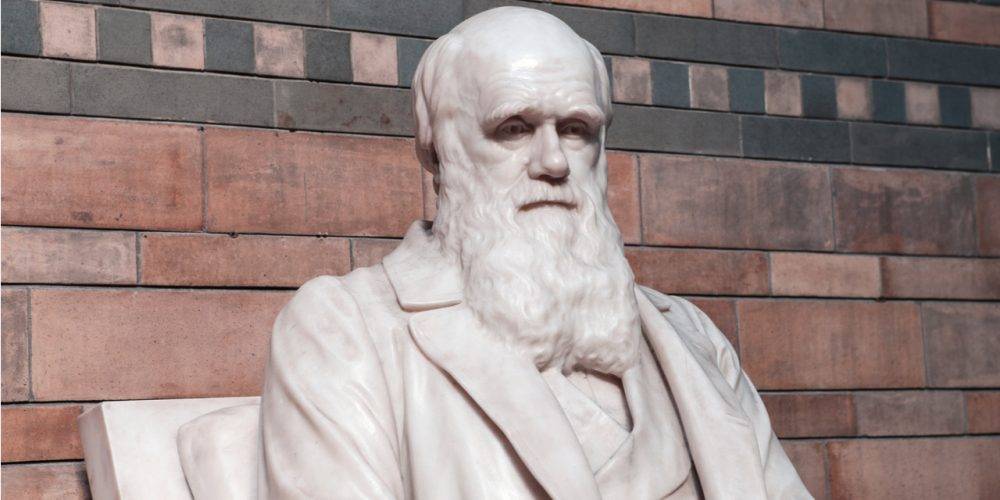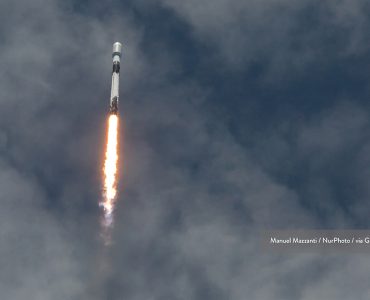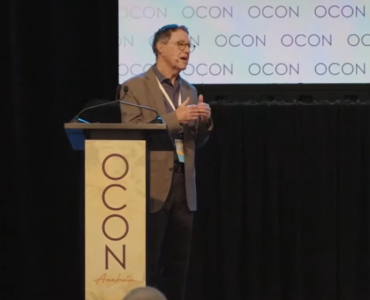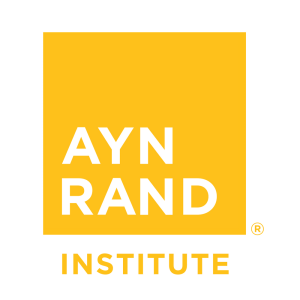According to a recent Gallup poll, 40 percent of Americans believe in creationism, agreeing most closely with the view that “God created human beings pretty much in their present form at one time within the last 10,000 years or so.” By contrast, only 22 percent agree most closely with the view that “Human beings have developed over millions of years from less advanced forms of life, but God had no part in this process.”1
Such widespread rejection of the theory of evolution is fueled in part by the notion that evolution is “just a theory.” This is the idea that evolution is just a speculative hypothesis — on a par with the biblical creation myth — with little-to-no basis in hard, scientific evidence.
The first thing to note about this claim is that it is simply not true — but even worse than the falsehood of the just-a-theory claim is the fact that it represents a grave injustice. To declare that evolution is “just a theory” is to suggest that Charles Darwin was “just a theorist” — that he was some sort of armchair scientist, spinning out scientific guesses in a vacuum instead of drawing his ideas from careful observations of nature. The just-a-theory allegation implies that Darwin formulated his theory without ever getting his hands dirty. But the truth is: Darwin got his hands dirty.
Darwin’s theory of evolution by natural selection is the product of a monumental, lifelong effort to collect and integrate mountains of factual evidence. He developed it only after assembling and reflecting on a large body of compelling observations and data. And he devoted his entire life to finding and gathering facts and arguments supporting the theory, and to considering every possible objection and implication.
In this three-part article, we’ll explore Darwin’s life and work, focusing on the process that he went through to amass and organize the enormous volume of evidence that he used to develop and validate his theory.
Darwin’s Early Life and Education (1809–1831)
Charles Robert Darwin was born February 12, 1809, in Shrewsbury, England, just northwest of Birmingham. He was born into Jane Austen’s England; Pride and Prejudice would be published just four years later. His father, Robert Darwin, was a wealthy doctor; and his mother, Susannah, was the daughter of the pottery magnate Josiah Wedgwood.
Charles Darwin grew up on a country estate and had ample opportunity to develop his early interest in the world of nature. In addition to the surrounding woods and the nearby river, the estate had a large greenhouse for him to explore, and his mother had a collection of fancy pigeons that she kept as pets. As a young boy he began collecting all sorts of things: shells, rocks, insects, bird’s eggs, and more. He would collect plant specimens and try to identify them. By the age of ten, he had developed the habit of wandering off for hours to go bird watching or insect hunting.
Embed from Getty ImagesDarwin was not a very hardworking student. He was completely uninterested in the classical education he received at the local school and did only the bare minimum of work necessary to get by. His father decided that Charles should follow in his own footsteps and become a doctor, so at the age of sixteen Charles was sent off to Scotland to Edinburgh University to study at its world-renowned medical school.
At university, Darwin was also an indifferent student — at least when it came to the classes in medicine he was taking. But he was interested in such activities as taking excursions to the Scottish coast to collect specimens of marine animals. He did not enjoy his anatomy classes, but just for fun he took private lessons in taxidermy.
One incident that occurred in his first year at Edinburgh basically put the writing on the wall regarding his career as a doctor. As a medical student he was required to observe surgical operations, which, in 1825, were far from the relatively safe and anesthetized affairs of today. One that he attended, on a small child, was so gruesome that he left in horror and never again set foot in an operating theater.
In his second year at medical school, he signed up for a number of classes on . . . geology and natural history. He studied techniques for preserving and labeling plant and animal specimens for collection and analysis, techniques that, as one biography points out, are “completely useless for anyone seriously intending to practice medicine.”2
Darwin joined a natural history society and, with friends he made there, went on geological expeditions and trips to the coast to muck around in tidal pools. One of these friends was Robert Grant, a lecturer from the university who was a world-renowned expert on marine invertebrates. Under Grant’s tutelage, Darwin learned how to dissect and analyze organisms, and he made original contributions of his own to Grant’s research on primitive marine creatures.
Darwin continued his medical studies for a while, but his heart was clearly elsewhere, and, once again, he did only the bare minimum necessary to get by. At the end of his second year at Edinburgh, he gave up on medicine and left the university without a degree. At this point, Charles’s father was getting a bit frustrated. His father was not going to let him squander his inheritance pursuing fruitless hobbies; he decided that if Charles was not going to be a doctor, then he needed to do something else that would at least be respectable. If Charles did not want to continue with medicine, then he would have to study for the church and plan for a life as a respectable country clergyman. So Charles was sent off to Cambridge to study divinity — which he did with about as much enthusiasm as he had done medicine. What really interested him at Cambridge was collecting beetles, which was all the rage at the time, and his obsession with building and studying his beetle collection was the beginning of a lifelong interest in entomology.
Embed from Getty ImagesIn spite of Robert Darwin’s most sincere efforts to shape his son’s future, there was no denying that what Charles was really passionate about was natural science. He did complete his bachelor’s degree in divinity; he spent the required three years at Cambridge and, by cramming like crazy in his third year, he managed to pass his final exams. But he spent most of his time during those three years pursuing his other interests.
He became friends with a botany professor by the name of John Henslow and took three years worth of botany classes from him (not exactly essential for an Anglican priest in training). Henslow encouraged him to read a six-volume book by the scientific explorer Alexander von Humboldt describing Humboldt’s travels and scientific discoveries in South America. This really fired up Darwin, and it planted the idea in his mind of setting off around the world and exploring the flora and fauna of exotic lands.
Embed from Getty ImagesDarwin also began studying with Adam Sedgwick, a prominent field geologist and professor of geology at Cambridge. Recognizing young Darwin’s talent and enthusiasm, Sedgwick took him under his wing. He took Darwin on expeditions and taught him the rigorous techniques of geological fieldwork (again, not exactly a critical skillset for the priesthood).
By the time Darwin graduated from Cambridge with his degree in divinity, he was, as one biography put it, “thoroughly versed in botany and entomology, had more than a smattering of zoology, knew how to prepare and preserve specimens, [and] was an expert field geologist who had been taught his trade by one of the Vice-Presidents of the Geological Society of London.”3
In other words, when Darwin left for home to begin preparing for his career in the church, he was thoroughly trained and ready . . . for a career as a scientist. And the big question he faced was: What was he going to do with all that training?
The Voyage of the Beagle (1831–1836)
Fortunately for Darwin, and for the rest of mankind, the perfect opportunity arose. On the recommendation of Professor Henslow, who had contacts in the British Admiralty, Darwin was invited to accompany the captain of the HMS Beagle, which was being sent to conduct a survey of coastal South America. On December 27, 1831, the Beagle set sail on what would end up being a five-year voyage circumnavigating the globe.
Embed from Getty ImagesThe journey gave Darwin an unparalleled opportunity to immerse himself in the work of making detailed, firsthand, scientific observations of nature. He was invited on board partly to serve as a gentleman companion to the captain and partly to serve as the ship’s naturalist. And in those days, the job of the ship’s naturalist was to conduct a systematic, scientific analysis of the regions visited on the journey — to observe and study the flora and fauna, to collect plant, animal, and geological specimens, and so on.
At various points of the voyage, Darwin left the ship and set off inland, sometimes for months at a time, before rejoining the Beagle and sailing on to the next port of call. He collected exotic beetles in the jungles of Brazil; he gathered seashells and sponges and corals from the coast of Patagonia (what is now Argentina); he collected specimens of birds and tortoises from the Galapagos Islands, west of Ecuador.
Embed from Getty ImagesDarwin amassed a huge collection of specimens, which he shipped back to England in crate after crate. Just as importantly, he filled notebook after notebook with his scientific observations — on the geology of the regions he explored, and on the plant and animal species he encountered.
One often sees images of Darwin as an old, bearded, Victorian gentleman, and it is tempting to think of him as a sedentary scholar, sitting in his armchair and philosophizing about nature. But the Darwin that one encounters upon reading about the Beagle voyage depicts exactly the opposite image: He is a vigorous, almost swashbuckling young man, tramping off into the Brazilian jungle with his notebook and his shotgun.
With his own hands, he dug out of cliff walls fossils of ancient creatures the size of horses. He hunted for his own supper almost as much as for biological specimens — eating, for example, such delicacies as roasted armadillo. On one occasion, he had eaten half of a large ostrich-like bird when he suddenly realized that it was an unusual species that hadn’t been described before. So he packed up the rest of the roast to ship home with his other specimens! Darwin was not an armchair scientist; he did not just theorize in a library, shut off from the world outside. He was an active observer of nature who traveled to the far corners of the world gathering facts and who got his hands dirty, literally. Embed from Getty ImagesBy the time Darwin returned to England after five years’ traveling the world, he had amassed a wealth of factual data. One biography summarizes his haul as follows: He had “1383 pages of geology notes, 368 pages of zoology notes, a catalogue of 1529 species in spirits and 3907 labeled skins, bones and miscellaneous specimens, as well as a live baby tortoise from the Galapagos Islands.”4
Darwin had already sent parts of his 770-page diary home, and they were already being circulated among England’s scientific elite, who were eager to embrace him as one of their own.
Embed from Getty ImagesBut in addition to his notes and his specimens, and the respect these won for him among scientists, Darwin got an unexpected benefit from his travels: The Beagle voyage helped him to find his true calling in life. It set him on the path to engaging in the work that would occupy the rest of his days — indeed, the work that would eventually bring about a major revolution in science.
Before he had even set foot back on the shores of England, Darwin had formulated a new plan for his future. After five years of single-mindedly pursuing scientific discovery, the notion of going home and settling down in a church parsonage was simply out of the question. He was determined to forge a career for himself as a gentleman scientist.
It is important to recognize that the mass of notes and specimens that Darwin had accumulated were not completed scientific discoveries; they were just the raw material for scientific discovery. Darwin understood perfectly well that that raw material had to be processed, studied, digested — converted into useful products, which for a scientist means scientific papers, lectures, treatises. For Darwin to return home and do nothing with the fruits of his scientific harvest would render his collection a heap of junk and his five-year journey a waste of time and effort.
Upon his return, and with his father’s support — both moral and, more importantly, financial — Darwin set to work. His first order of business was to find a home for his collection and to delegate the detailed analysis of his specimens to experts in different fields. Darwin’s education had exposed him to broad areas of natural science, but to fully and properly reap the fruits of his Beagle findings, he would have to farm out parts of the work to specialists who were highly trained in particular areas.
He had his fossil specimens studied by a leading expert in comparative anatomy, his mammals cataloged by the museum curator of the London Zoological Society, his reptiles examined by a zoology professor at King’s College, and his plants studied by a team of botanists. He delegated the study of his birds to an expert ornithologist who discovered, much to Darwin’s surprise, that the birds he had brought back from the Galapagos Islands — which he thought composed a fairly diverse collection — were in fact almost all different species of the common finch.
Darwin himself undertook the work of writing up his geological findings. At this point in his life, Darwin considered himself to be primarily a geologist, not a biologist, and his main priority was reporting the geological observations he had made on his travels. At the same time, he was positively brimming with questions raised by his observations, questions in the field of biology as much as in that of geology. The most important question that captured his attention was one of the most important mysteries of Darwin’s day: the mystery of the origin of species.Evolution Before Darwin
At the time of Darwin’s return to England in 1836, the question of how all the various living species originated was ripe for serious scientific consideration. About a century earlier, Carl von Linnaeus had introduced the modern system of biological classification, organizing all living species into nested groups of genus, order, class, and so on. Linnaeus’s system is based on a hierarchy of similarities and differences among the species, and forms a branching, tree-like structure that looks curiously like a family tree.
Embed from Getty ImagesIn Linnaeus’s day, however, this similarity to a family tree would have been regarded as only a curious coincidence. Few would have suspected that all living species are actually related to each other in the same way in which you are related to your second (and 102nd) cousins. The prevailing view was, of course, the creationist view that each species was formed independently by a special act of miraculous creation.
Furthermore, it was generally held that species are immutable, unchanging. After all, the book of Genesis describes all living creatures as reproducing “after their kind,” meaning that the offspring resemble the parents. The commonly held view was that species might be capable of a certain amount of variation but only within tightly circumscribed limits. The notion that, say, birds and reptiles are distant cousins on a single family tree is one that most people would have found absurd.
Embed from Getty ImagesOn the other hand, speculation along the lines of evolution went back to ancient Greece. A handful of thinkers before Darwin had put forward the idea that species are related — that life began in some primitive form and then gradually changed, transforming by some mechanism, and branching out into all the diverse species alive today. In fact, Darwin’s own grandfather, Erasmus Darwin, was one such thinker; in the 1790s he wrote a book called Zoonomia that included a vague hypothesis about the evolutionary origin of species.
The most influential theory of evolution before Charles Darwin’s was put forward by French biologist Jean Baptiste Lamarck in the first two decades of the nineteenth century. Lamarck proposed that species are not unique, independent creations but are the modified, transformed descendants of other species. He took seriously the family-tree-like structure suggested by the Linnaean system and proposed a theory to explain how species change.
Embed from Getty ImagesAs a young man, Charles Darwin read Lamarck’s writings and was impressed by a couple of points. For one thing, Lamarck was seeking natural as opposed to supernatural explanations. Darwin recognized a pressing need to see biology as a field governed by scientific law — just as physics, astronomy, and chemistry had come to be seen. Later, in Origin of Species, Darwin would praise Lamarck by saying that he did “the eminent service of arousing attention to the probability of all change in the organic, as well as in the inorganic, world being the result of law and not of miraculous interposition.”5
Darwin was also impressed by some of the evidence that Lamarck tried to bring to bear on the subject, evidence showing that species are not always markedly different from each other. In some groups of organisms there is an almost continuous variation in characteristics among different species in a group, which makes it plausible to view them as the gradually modified descendants of a common ancestor, rather than as a number of independently created species.
Although Darwin found certain valuable elements in Lamarck’s evolutionary theory, he was not impressed with Lamarck’s proposal for the causal mechanism driving evolutionary change. Lamarck held that changes occur as a result of organisms striving to be better adapted to their environment; this striving causes slight changes in their characteristics, which are then passed on to their offspring and build up over generations. Lamarck’s classic example of this is a giraffe stretching up to the leaves on branches just out of reach. Striving to reach the higher leaves stretches the giraffe’s neck slightly and it then produces baby giraffes with slightly longer necks. If this were to continue generation after generation, one could explain the transformation of a giraffe ancestor with a normal-sized neck into the modern giraffe.
Embed from Getty ImagesThe problem with Lamarck’s explanation is that it simply is not true that characteristics acquired during an organism’s life are passed on in reproduction. If you were to dye your hair green or lose an arm in an accident, you would not expect to then have a baby with green hair or a missing arm.
Darwin was also, as one would expect, aware of his grandfather’s writings on evolution, which are strikingly similar to those of Lamarck. Erasmus Darwin was quite famous in his day, and his writings were part of the family lore. Charles had read Zoonomia as a young man and rather admired it. But neither Erasmus Darwin nor Lamarck had a fully convincing argument for evolution. Their works were too speculative and insufficiently supported by evidence and facts. In his autobiography, Charles Darwin writes that upon reading Zoonomia for a second time, he was “much disappointed, the proportion of speculation being so large to the facts given.”6 Embed from Getty Images
Hence, when Darwin set sail around the world, he was, like almost every other scientist in his day, a firm believer in “special creation.” He was aware of evolutionary thinking but held the commonly accepted view that each species was created independently of every other species. At the same time, however, he was becoming aware of other developments in early nineteenth-century science that would prove to be highly suggestive of evolution.
In geology, scientists had reached the conclusion that the major features of the earth are the result of slow, gradual changes built up over long periods of time. They had thrown out the attempt to explain earth’s geology by means of supernatural cataclysms such as Noah’s flood. But the geologist Charles Lyell had gone further and thrown out the appeal to cataclysms as such. In his Principles of Geology, he argued that even the largest-scale effects in geology, such as the raising of massive mountain ranges or the carving out of deep canyons, are the result not of massive, catastrophic events but of small-scale, everyday processes acting over unimaginably long time scales.
Embed from Getty ImagesOn board the Beagle, Darwin read the first volume of Lyell’s three-volume treatise, which had been published in 1830. From his geological observations during the voyage, Darwin saw the truth of Lyell’s views writ large on the very rocks themselves. As he set about collecting plant and animal specimens, the Lyellian idea of incremental changes accumulated over vast ages was at the forefront of Darwin’s mind.
End of Part 1. Read Part 2.
Join the conversation. Follow us on Facebook and Twitter.
Readers seeking a superior print result may wish to download the free Just Read app.
Do you have a comment or question?
Endnotes
- https://news.gallup.com/poll/261680/americans-believe-creationism.aspx
- Michael White and John Gribbin, Darwin: A Life in Science (New York: Plume, 1997), 123.
- White and Gribbin, Darwin, 125–26.
- White and Gribbin, Darwin, 80.
- Charles Darwin, The Origin of Species (New York: Barnes and Noble Classics, 2004), 386.
- Charles Darwin, The Autobiography of Charles Darwin: 1809–1882, edited by Nora Barlow (New York: Norton, 1958), 49.







